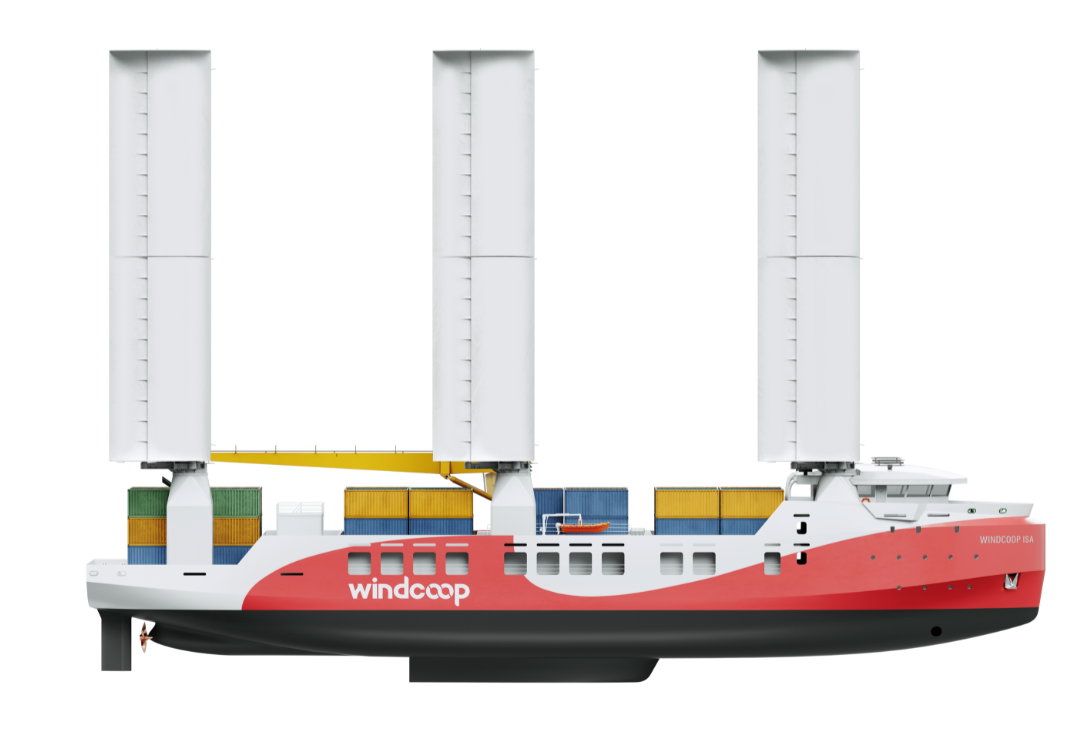A sail-powered container ship financed by citizens’ cooperative

What if maritime transport became a common good again?
Windcoop is building the world’s first wind-powered container ship, financed using a cooperative model. The vessel belongs to its members – citizens, shippers, businesses and local authorities – who have raised 6.8 million euros in equity, directly contributing to financing its construction, estimated at 28.5 million euros.

Vessel technical features
▪️Lenght: 91,3 metres
▪️Width: 17,8 metres
▪️Draught: 4,8 metres
▪️Air draught : 62 metres
▪️Capacity : 210 TEU (around 2,500 tonnes of goods)
▪️Reefer plugs : 40
▪️CO₂ saving targeted: Up to 60 %
▪️Surface vélique: 1,050 m² – 3 rigid wingsails of 350 m²
▪️Auxiliary engine: MGO diesel fuel motor
▪️Autonomous on-board crane for self-handling in ports
▪️Crew: 10 to 12 seafarers
▪️Passengers places: 12
▪️Flag : RIF (French International Register)
Sailing to the rhythm of the Wind
The vessel will be able to accommodate up to 12 passengers, who will experience life at pace set by the crew. We are not offering a luxury cruise, but the chance to travel with the wind, comfortably, and to enjoy an uncommon journey aboard one of the first cargo sailing ships in operation.

A low-carbon shipping logistics

A World First in Containersised Transport
While most sail-powered cargo ships focus on palletised or Ro-Ro freight, Windcoop is leading the way by adapting wind propulsion to container shipping. This is a groundbreaking challenge, solved through an innovative asymmetrical design. The sails and crane are positioned in a complementary way, allowing the ship to operate fully autonomously during port calls
Optimized to Sail with the Wind
The vessel is design to reach an average speed of 9 knots, with the ability to accelerate using wingsails when there’s a tailwind. The sailing system features three rigid, fixed-profile wingsails, mounted on a tripod axle. Containers are stacked across six levels in three open holds. If there is no wind, a backup MGO diesel engine kicks in to ensure continuous navigation.
Up to 90 % Fuel Savings
Thanks to its sails, the Windcoop cargo ship can save up to 90% on fuel, depending on the route and season. This estimate is based on navigation simulations by D-ICE Engineering, using weather data from the past decade. These results gives us a solid understanding of fuel savings and will allow us to fine-tune the balance between sail and engine power for each journey.
Technical pillars of Windcoop sailing cargo

Expertise : Zéphyr & Borée
Co-funder of the projec, Zéphyr & Borée brings its expertise in the design, construction and management of wind-powered vessels, building on its own experience with the cargo ship Canopée.

Construction : RMK Marine
The vessel will be built by RMK Marine, a leading Turkish shipyard. It built the Neoliner, an iconic sailing cargo. The Windcoop vessel launch is due in May 2027.

Sails technology: CWS
Windcoop relies on the latest generation of sail propulsion developed by CWS. Its three automated rigid wings combine power, stability and a low-energy, wind-reliant design.

An optimised and replicable vessel, designed thanks to the LCA

The Windcoop vessel is designed as a replicable vessel. To support this objective, a Life Cycle Assessment (LCA) is being carried out with the consulting firm Hévéa and the French Agency for Ecological Transition (ADEME). This LCA will provide a comprehensive and objective measurement of the vessel’s environmental, economic, and social impacts, from design to end-of-life. This rigorous approach will serve as a foundation to enhance the performance of future vessels and refine design, operational, and financing decisions.
